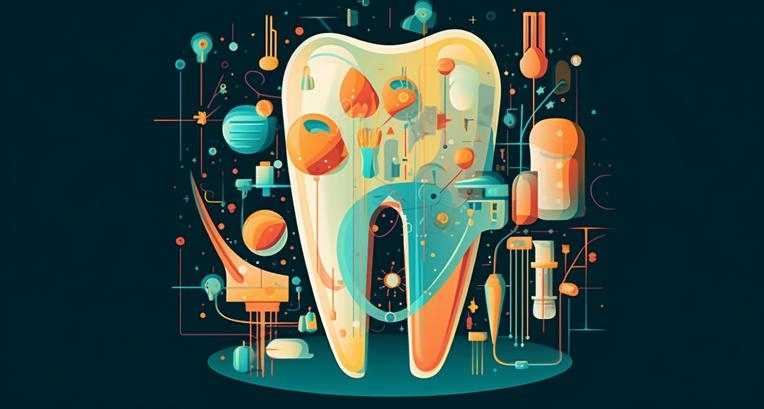Nanotechnology in Dentistry: A Closer Look
 As I sat in the waiting room of my dentist's office, leafing through a stack of outdated magazines, I stumbled upon an article that caught my attention, like a piece of spinach stubbornly wedged between my molars. The headline declared: "Nanotechnology in Dentistry: A Closer Look." Intrigued by this fascinating development in the world of oral care, I decided to delve deeper into the abyss of nanotech dentistry and its potential implications.
As I sat in the waiting room of my dentist's office, leafing through a stack of outdated magazines, I stumbled upon an article that caught my attention, like a piece of spinach stubbornly wedged between my molars. The headline declared: "Nanotechnology in Dentistry: A Closer Look." Intrigued by this fascinating development in the world of oral care, I decided to delve deeper into the abyss of nanotech dentistry and its potential implications.
The Microscopic World of NanotechnologyBefore we dive headfirst into the dental applications of nanotechnology, let's first explore the strange and minuscule world of nanotech itself. The term "nano" refers to a billionth of a meter, which is about the size of an atom or a molecule. Now, imagine creating materials and devices at this atomic scale - welcome to nanotechnology! This rapidly evolving field has the potential to revolutionize various industries, including medicine, electronics, and even dentistry.
Reinventing Dental MaterialsAs I pondered the possible ramifications of nanotechnology in dentistry, my mind wandered to the dreaded task of replacing a chipped tooth. A night of vigorous flossing had led to the unfortunate demise of one of my pearly whites, much to my dismay. But what if, through the sorcery of nanotechnology, this chipped tooth could be restored with a material that was not only more durable but also boasted antibacterial properties? Enter nano dental composites. These materials are made from nanoparticles of silica and are designed to mimic the natural appearance and function of teeth, while also inhibiting the growth of harmful bacteria. Truly, a marvelous feat of modern dentistry!
The End of Fillings?The mere thought of a dental drill whirring and whining as it bores into a cavity-ridden tooth is enough to send shivers down the spine of even the most stoic individual. However, nanotechnology may soon render this torturous procedure a relic of the past. Researchers are developing nanoparticle-based treatments that can repair tooth decay by regenerating enamel and dentin, the hard tissues that make up the tooth. Imagine a world where cavities could be banished with the simple application of a gel! Now that's something to smile about.
Oral Cancer DetectionAs I sat in the dentist's chair, mouth agape and drooling like a St. Bernard, I couldn't help but feel a pang of fear as the dentist examined my mouth for any signs of oral cancer. Luckily for me, my oral cavity was given the all-clear. But for the countless individuals who face a diagnosis of oral cancer each year, nanotechnology may soon offer a more effective and less invasive means of detecting the disease. Researchers are exploring the use of nanoparticles to target and identify cancerous cells in the mouth, potentially paving the way for early detection and treatment.
A Brighter Future for BracesAs someone who endured years of teenage torment at the hands of metal braces, the notion of a more discreet and comfortable alternative was nothing short of intoxicating. Nanotechnology may soon deliver just that, in the form of nanoparticle-infused brackets and wires designed to apply a gentler, more consistent force to misaligned teeth. While the teenage version of myself would have traded a kidney for such a marvel, I must now content myself with the knowledge that future generations may be spared the social stigma of "brace-face."
The Ethics of NanodentistryAs with any scientific advancement, the marriage of nanotechnology and dentistry is not without its ethical concerns. While the potential benefits are undoubtedly tantalizing, there are questions surrounding the long-term safety and environmental impact of using nanoparticles in dental applications. As we stand on the precipice of a nanotech dental revolution, it is crucial that we don our thinking caps (complete with steel reinforcement and extra padding, of course) and carefully consider the ramifications of this brave new world of microscopic dental wonders.
ConclusionAs I left the dentist's office, mouth sore but cavity-free, I couldn't help but marvel at the future of dentistry that may soon be upon us. From regenerating tooth enamel to detecting oral cancer, nanotechnology has the potential to reshape the way we care for our teeth and gums. As I walked down the street, nursing my tender gums and cursing the inventor of dental floss, I couldn't help but crack a grin - nanodentistry may be closer than we think, and it's sure to leave us all smiling.
|
|







 As I sat in the waiting room of my dentist's office, leafing through a stack of outdated magazines, I stumbled upon an article that caught my attention, like a piece of spinach stubbornly wedged between my molars. The headline declared: "Nanotechnology in Dentistry: A Closer Look." Intrigued by this fascinating development in the world of oral care, I decided to delve deeper into the abyss of nanotech dentistry and its potential implications.
As I sat in the waiting room of my dentist's office, leafing through a stack of outdated magazines, I stumbled upon an article that caught my attention, like a piece of spinach stubbornly wedged between my molars. The headline declared: "Nanotechnology in Dentistry: A Closer Look." Intrigued by this fascinating development in the world of oral care, I decided to delve deeper into the abyss of nanotech dentistry and its potential implications.